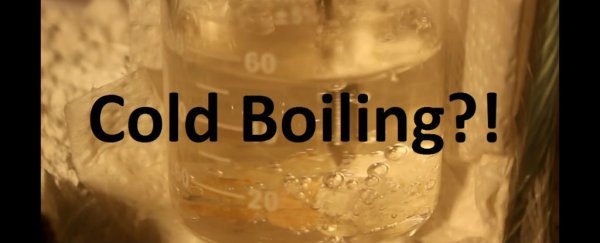If you feel like having one of your fundamental beliefs thrown out the window, try this on for size - under the right conditions, you can boil water until it freezes solid.
Yep, as the Cody's Lab video above demonstrates, after a few minutes of boiling, water starts to form solid ice crystals, and is actually cold to the touch. Crazy, right?
So what's going on here?
First, let's run through the set-up, because under normal circumstances, you're not going to be boiling anything frozen any time soon, so put that kettle away.
As the video explains, you need a pressure chamber, which uses a vacuum pump to suck out all the air in the area you're working with. Inside this, Cody sits a beaker containing 60 ml of room temperature tap water.
A salt made from magnesium sulphate anhydrous and a bottle coated in calcium sulphate are also placed up the back of the chamber.
These two substances aren't there to help the boiling-freezing process - they're to help absorb the water vapour so the pressure chamber isn't damaged by the build-up.
A few pieces of solid calcite are then added to the water as 'boiling chips', which won't affect anything temperature-wise, but will help the water boil more smoothly.
Okay, now everything's ready to go.
Inside the pressure chamber, the water isn't going to be boiled by increasing the temperature - instead, it's going to be boiled by decreasing the pressure.
As Cody explains, the boiling point of a liquid depends on both temperature and pressure, and the warmer the liquid, the higher the vapour pressure.
At 100 degrees Celsius (water's normal boiling point), the vapour pressure is 1 standard atmosphere, or 0.101325 megapascal (MPa). At this point, water starts to evaporate and switch states from a liquid to a vapour (steam).
At room temperature, water's vapour pressure is much lower, so it's stable and doesn't boil.
Using these principles, you can put room temperature water into a pressure chamber, start removing the air (therefore lower the pressure), and after a few minutes, the boiling temperature will fall below the water temperature, and you get boiling without heating.
"Theoretically, if I continue to lower the pressure, the water should continue boiling, and actually lose heat, because the water molecules bouncing around - the hottest ones, or the ones with the most kinetic energy - will leave as a gas, leaving the rest of them down in [the beaker] colder," says Cody.
You can see in the video above that as the water boils, its temperature actually dips to freezing point.
As the Physics Department at Harvard-Westlake School in California explains, when you boil water by lowering the pressure, the molecules that remain in a liquid state give energy to those that escape it as a gas.
"Clearly, molecules existing in the gaseous state have more kinetic energy than those unable to overcome intermolecular weak forces," they explain.
"Thus, as the boiling process proceeds, the liquid is constantly losing heat. Continuing to run a vacuum pump stops pressure of gaseous molecules from building up, allowing the boiling process to continue. … Eventually, the temperature of the liquid drops enough that it freezes."
So there you have it. Watch the video all the way through to see Cody boil the water so solid, he can't even get it out of the beaker.
Physics, you are awesome.
H/T Digg
